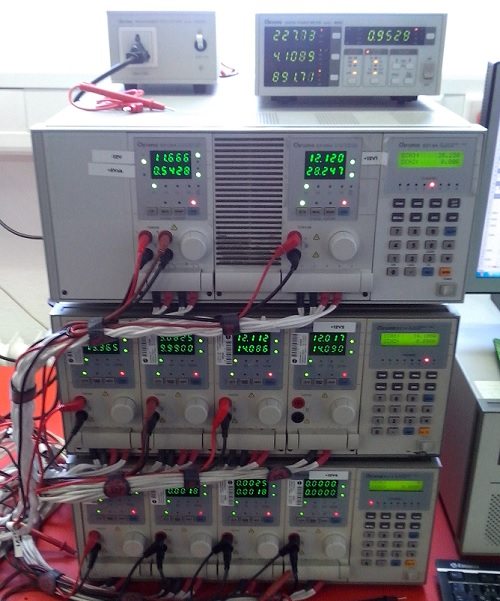Corsair GS800 (800W) Non-Modular Power Supply Review
Ryan Martin / 11 years ago
Test Procedure
At eTeknix we take the power supply testing procedure very seriously. For all power supply reviews we used a variety of Chroma machines and other digital power machinery provided by Enermax in their European test labs. We would like to say a huge thank you to Enermax for making this power supply testing possible.
The test machinery included the following:
- A Chroma 6314A power supply load tester with two add on 6314 modules to support up to six 12 volt rails.
- A Chroma Digital Power Meter Model 66202
- A Custom-made Enermax PCB circuit board to connect all the appropriate power supply cables
- A Tektronix TDS 3014C Digital Phosphor Oscilloscope
- A Voltcraft DT-10L Laser Tachometer

The eTeknix test procedure involves:
- Testing each power supply at 20/40/60/80/100% load (with balanced load across all rails) and measuring PFC (power factor correction), efficiency (actual power divided by power “pulled at the wall”) and voltage regulation (deviance from expected voltages of 3.3/5/12).
- Measuring ripple and noise with an oscilloscope at 20/40/60/80/100% load.
- Measuring voltage regulation and ripple/noise at Maximum 12v loads and maximum 3.3/5v loads while keeping the -12v and 5vsb consistently at 0.1A and 1A on the rail(s) not being tested. For example under 12v crossload we would load the 12v rail to its maximum and place 0.1A on the -12v and 5vsb as well as 1A on the 3.3v and 5v rails.
- Measuring fan speed after a stabilisation period of five minutes at each load scenario using the Voltcraft DT-10L laser tachometer and a reflective strip on the fan.
Other things to consider are that
- We recognise that a single yellow 12 volt cable can provide only 6 Amps before overheating (which corrupts voltage regulation and efficiency) and so we used an adequate number of cables for each power supply.
- Our power supply tester was capable of only 50 Amps on the 12 volt 1 rail, 50 Amps on the 12 volt 2 rail and 25 Amps on rails 3-6. This meant that for single 12 volt power supplies with rail Amps above 50 we had to split them virtually over two rails to maximise their load. There are no power supplies that we tested that have more than 50 Amps over two rails so this was only an issue for single 12 volt rail power supplies.
- We use the same time scale and horizontal millivolt scale on our oscilloscope for all noise and ripple tests.
- Deviance is the terminology used to represent the way voltages diverge from their expected values.



















